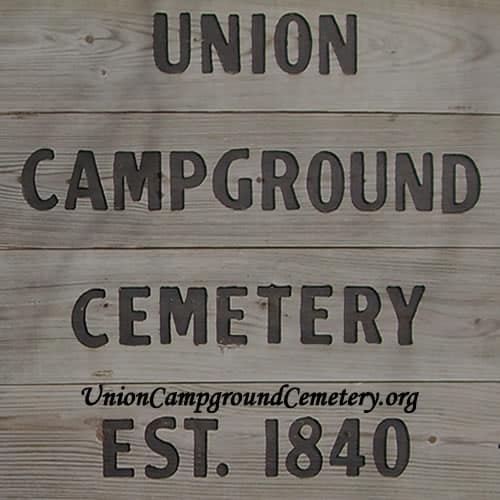Sarah Ann Warr Rathbone was born in Holstock, Dorsett, England in 1833. On June 9, 1847 she married Thomas Henry Rathbone in St. Peter’s Catholic Chapel, Warwick County, Birmingham District, England. Since she was very young and unable to write her name, she made an “X: mark on the marriage certificate.
The Rathbone and Warr families lived on Englenston Street in the City of Birmingham. The elder Rathbone was a cooper by trade and Sarah’s father, Samuel, was a button maker. (note: a cooper is a barrel maker).
Sarah and Thomas immigrated to the United States in 1850 or 1851, bringing along their two children, Bernardino and Theresa. During the voyage to the United States their sailing ship was blown off course and, since they were at sea long enough to run out of food, it became necessary to look for rats on board the ship, catch, cook and eat them.
After arriving in the United States the family settled in New York. In 1851 another son, John Thomas, was born, followed by the birth of William Henry in 1857. A year later, Thomas’ request for naturalization was finalized in Brooklyn, N.Y. The witness stated he was “well acquainted with the applicant … that he (Thomas Henry) behaved as a man of good moral character, attached to the principles of the Constitution of the United States … ” At that time, only the head of the family received documentation for naturalization, but it automatically included any dependents.
It was around 1859 that Thomas Henry and family migrated to Missouri and settled in Springfield. Another son, Samuel, was born in 1860, and on August 4, 1861, James Henry was born.
According to the Federal Census of 1860, Thomas H. Rathbone is listed as head of the household age 35; Sarah age 36; Bernard age 13; Terresa age 11; John age 6; William age 3; Samuel age 1. The 1870 census reveals James, age 91 added to the household but the name of Samuel does not appear. This child . probably died and is presumed buried in Union Campground Cemetery.
On March 23, 1863 a deed for approximately 99 acres in Township 29, Range 21, Section 3 was recorded from John J. Faulkner to Sarah Ann Rathbone for $100. This became known as the Rathbone Farm and adjoined a portion of land that is now Union Campground Cemetery. The Rathbones arrived on the farm too ate that year to make a crop and it became necessary to trade with the neighboring Dulin family a tea leaf pattern of ironstone china and some heavy silver plated flatware for wheat, corn and other food.
Through the years a story has been handed down in the Rathbone family concerning an incident that occurred during the Civil War. The family had settled into a life of farming but were always on the alert for soldiers who might be roaming the countryside. Their fears were realized one day when troops arrived on the property. Food and livestock were confiscated and the officer in charge handed Thomas Rathbone a detailed list of what had been taken. Thomas was told that after the war the government would make restitution. Thomas was so angry, however, he tore the list in shreds. After the war ended the government attempted to make restitution, but lacking verification, no compensation was granted.
“The Springfield, MO Land Office Sales Book 1833-1892 records that on January 2, 1872 the Rathbones acquired 39.58 acres in T29, R21, S3. In July 1874 the farm was sold. Later in that year Sarah Ann died and was buried in Union Campground Cemetery. The funeral folder published at the time of her death reads: “The funeral of Mrs. Sarah Ann Rathbone will take place at the Union Camp Ground, six miles northeast of the city, tomorrow, Wednesday, September 16, 1874 at 3 o’clock. The friends and acquaintances of the family are respectfully invited to attend.”
Paxson Funeral Home Records of Springfield, MO 1871-1900 indicate Thomas Rathbone purchased a #1 case and box for $25 on September 15, 1874. This coffin would have been hauled by wagon from the funeral home to the farm. From the farm the entourage would have traveled the narrow dirt road paralleling the Little Sac River to the eastern edge of the cemetery. The pallbearers would have then removed the coffin from the wagon and carried it to the gravesite.
Sarah’s tombstone cannot be located today the only clue s to its possible location comes from an account given by Erma Rathbone Erickson, now deceased, who was a great granddaughter of Sarah. Years ago, at the conclusion of a musical program, she was presented with a bouquet of roses, and she decided to go to Union Campground to place the flowers on Sarah’s grave. As she approached the grave she had to enter a wrought iron enclosure. (This also agrees with a story told by Ross Rathbone, a great grandson of Sarah, who related entering an iron gate to her grave.)
An intact, wrought iron enclosure surrounds the W. N. McMurry family plot; a smaller wrought iron enclosure surrounds four unmarked graves; and remnants of another wrought iron enclosure are scattered throughout the cemetery. Perhaps at one time, these scattered remnants surrounded the graves of Sarah and her son, Samuel.
The above genealogy is based on material written by Betty Jane Rathbone Turner, great granddaughter of Sarah Ann (Warr) Rathbone.
By Jean Rayl 2001
